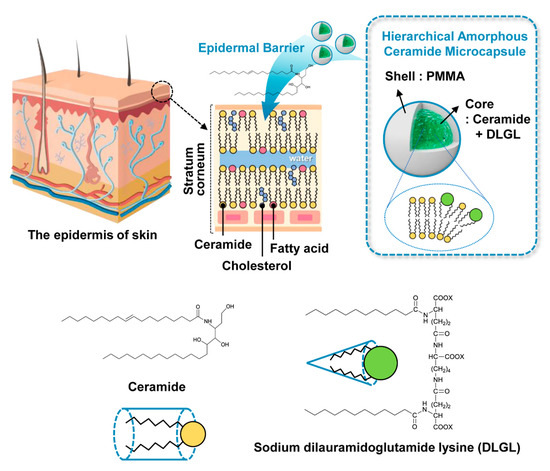
| Version | Summary | Created by | Modification | Content Size | Created at | Operation |
|---|---|---|---|---|---|---|
| 1 | Jun Hyup Lee | + 411 word(s) | 411 | 2020-09-23 06:08:57 | | | |
| 2 | Catherine Yang | Meta information modification | 411 | 2020-10-20 06:07:19 | | | | |
| 3 | Catherine Yang | + 10 word(s) | 421 | 2020-11-09 09:47:44 | | | | |
| 4 | Catherine Yang | Meta information modification | 421 | 2020-11-10 03:12:27 | | |
Video Upload Options
As a main component of the stratum corneum, ceramides can construct protective lamellae to provide an epidermal barrier against dehydration or external microorganisms. However, as ceramide molecules can easily form the isolated crystalline phase through self-assembly due to the amphipathic nature of bioactive lipids, the effective incorporation of ceramides into liquid media is the remaining issue for controlled release. Here, we report an unprecedented effective strategy to fabricate a completely amorphous and highly sustainable hierarchical ceramide polymer microcapsule for promising epidermal barrier by using the interpenetrating and cooperative self-construction of conical amphiphiles with a different critical packing parameter. The self-constructed amorphous architecture of ceramides in polymer microcapsule is achieved by the facile doping of conical amphiphiles and subsequent in situ polymerization of shell polymer in the core-shell geometry. It is experimentally revealed that an irregular cooperative packing structure formed by adaptive hydrophobic–hydrophilic interactions of cylindrical ceramides and conical amphiphiles in the confined microcapsule geometry enables a completely amorphous morphology of ceramides to be realized during the spontaneous encapsulation process. Furthermore, this elegant approach affords a highly dispersible and uniform hierarchical amorphous ceramide microcapsule with a greatly enhanced long-term stability compared to conventional crystalline ceramides.
1. Introduction
Herein, we present an unprecedented yet simple, effective, scalable strategy for the fabrication of completely amorphous and highly sustainable hierarchical ceramide microcapsules for potential epidermal barrier based on the interpenetrating and cooperative self-construction of conical amphiphiles with a different critical packing parameter in the confined geometry of polymeric microcapsule (Figure 1).
2. Illustration of the fabrication of hierarchical amorphous ceramide microcapsules
The inherent concept which can construct the self-assembled hyperstructure of amphiphilic molecules depending on the molecular geometry is applied to the fabrication of the self-constructed amorphous architecture of ceramides in polymer microcapsule [1]. Notably, novel hierarchical amorphous ceramide microcapsule containing the interpenetrated cylindrical ceramide and conical sodium dilauramidoglutamide lysine (DLGL) as core materials could be facilely prepared in a large quantity using simple doping of DLGL amphiphile and subsequent in situ polymerization of PMMA shell in the core-shell geometry. The adaptive hydrophobic–hydrophilic interactions of cylindrical ceramides and conical DLGL amphiphiles enable an irregular cooperative packing structure inside the hierarchical PMMA microcapsule, thereby providing a completely amorphous morphology of ceramides during the spontaneous encapsulation process. In addition, excellent long-term durability of amorphous ceramide microcapsules with high dispersibility in the liquid media could be achieved compared to that of common crystalline ceramides.

Figure 1. Schematic illustration of the fabrication of hierarchical amorphous ceramide microcapsules for potential epidermal barrier.
References
- Carrer, D.C.; Maggio, B. Transduction to Self-assembly of Molecular Geometry and Local Interactions in Mixtures of Ceramides and Ganglioside GM1. Biochim. Biophys. Acta 2001, 1514, 87–99.




